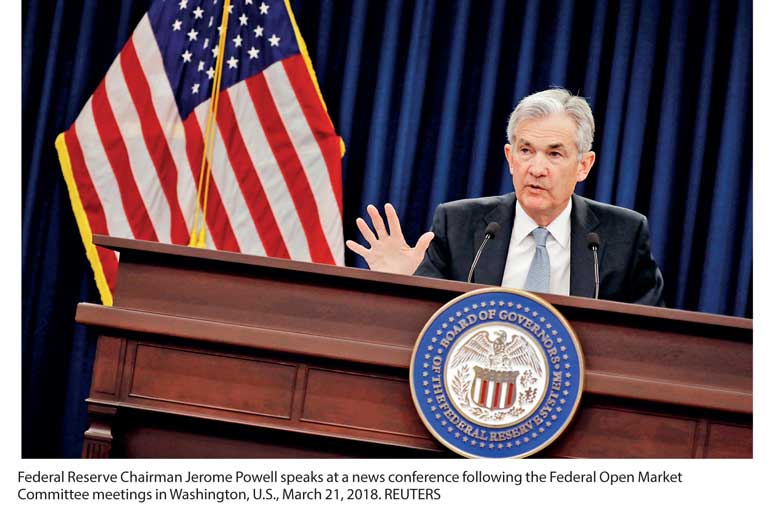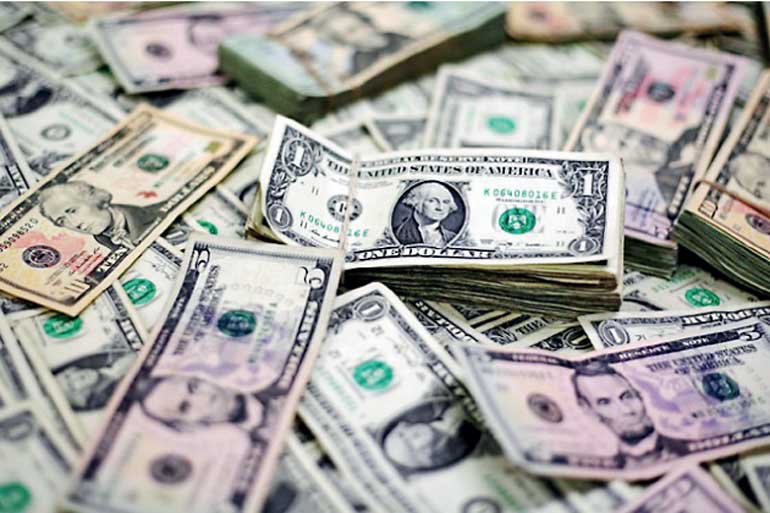Thursday Dec 18, 2025
Thursday Dec 18, 2025
Friday, 23 March 2018 00:00 - - {{hitsCtrl.values.hits}}
 WASHINGTON (Reuters): The US Federal Reserve raised interest rates on Wednesday and forecast at least two more hikes for 2018, highlighting its growing confidence that tax cuts and government spending will boost the economy and inflation and spur more aggressive future tightening.
WASHINGTON (Reuters): The US Federal Reserve raised interest rates on Wednesday and forecast at least two more hikes for 2018, highlighting its growing confidence that tax cuts and government spending will boost the economy and inflation and spur more aggressive future tightening.
In its first policy meeting under new Fed chief Jerome Powell, the US central bank indicated that inflation should finally move higher after years below its 2% target and that the economy had recently gained momentum.
The Fed also raised the estimated longer-term “neutral” rate, the level at which monetary policy neither boosts nor slows the economy, a touch, in a sign the current gradual rate hike cycle could go on longer than previously thought.
“The economic outlook has strengthened in recent months,” the Fed said in a statement at the end of a two-day meeting in which it lifted its benchmark overnight lending rate by a quarter of a percentage point to a range of 1.50% to 1.75%.
Powell, who took over from former Fed chief Janet Yellen in early February, said the central bank was staying on a path of gradual rate increases but needed to be on guard against inflation.
“We are trying to take the middle ground here,” Powell said in a press conference after the end of the policy meeting, adding that there were no signs the economy was on the cusp of accelerating inflation.
The rate hike was widely expected. All 104 economists polled by Reuters from March 5-13 said the Fed would increase borrowing costs this week.
US stocks rose after the policy statement before paring gains to close lower. US Treasury yields fell and then recovered. The dollar recorded its steepest one-day loss in nearly two months against a basket of currencies.
“The guidance in terms of the future rate hikes is a touch more hawkish than originally expected. 2019 looks like we’re going to get a faster pace of rate hikes,” said Matt Miskin, market strategist at John Hancock Investments.
“This a new Fed chairman starting with a bit of a hawkish tone as he takes leadership.”
The rate hike was the latest step away from years of stimulating the world’s largest economy in the wake of the 2007-2009 financial crisis and recession. The Fed tightened policy three times last year.
The combination of $1.8 trillion in expected fiscal stimulus from the Trump administration and recent hints of price and wage pressures had prompted some Fed officials to speculate more Americans could be drawn into an already tight labour market.
Some even worried inflation could rise well above the Fed’s target if the economy got too hot.
Policymakers were largely split on Wednesday as to whether a total of three or four rate hikes would be needed this year. They predicted rates would rise three times next year and two times in 2020, a further indication of their view that the economy is on solid footing.
“The Fed seems to be gaining confidence,” said Brian Coulton, an economist at Fitch Rating in London.
Fed policymakers projected US economic growth of 2.7% in 2018, an increase from the 2.5% forecast in December, and also marked up growth for next year. The Fed’s preferred measure of inflation was expected to end 2018 at 1.9%, unchanged from the previous forecast, but it is seen rising a bit above the target next year.
The US unemployment rate by the end of 2018 is expected to edge down to 3.8%, indicating the Fed sees more room for the labour market to run. Fed officials predicted the longer-run rate would settle at 4.5%, slightly lower than the forecast from December.
US joblessness stood at 4.1% last month.
While recent home sales and retail spending data have been on the weak side, the overall economic picture has brightened after growth accelerated to 2.3% last year.
Before the meeting, analysts were split over whether the Fed, which is wary of an early misstep under its new leadership, would raise policy tightening expectations until more price pressures are clearly evident. There are also looming outside risks to the economy such as a possible global trade war.
“This is a new risk (that) had been probably a low-profile risk, but which has become ... a more prominent risk to the outlook,” Powell said, adding, however, that the trade tensions had not affected the Fed’s expectations for the economy.
 TOKYO (Reuters) - The U.S. dollar slipped on Thursday after the Federal Reserve held back from increasing the pace of this year’s rate hikes, while worries over an impending announcement on trade tariffs from U.S. President Donald Trump capped Asian shares.
TOKYO (Reuters) - The U.S. dollar slipped on Thursday after the Federal Reserve held back from increasing the pace of this year’s rate hikes, while worries over an impending announcement on trade tariffs from U.S. President Donald Trump capped Asian shares.
MSCI’s broadest index of Asia-Pacific shares outside Japan was flat, erasing earlier gains of 0.7 pct. Japan’s Nikkei gained 1.0%.
European shares are expected to fall, with spread-betters looking to a lower opening of 0.4% in Germany’s Dax , 0.2% in Britain’s FTSE and 0.1% in France’s Cac.
Wall Street stock indexes ended the day lower, with the S&P 500 losing 0.18% despite a boost from sharp gains in energy shares on rising oil prices.
The Nasdaq dropped 0.26% with Apple falling below its 100-day average even as Facebook bounced back after two days of steep losses amid a controversy over outside exploitation of its users’ data.
The U.S. Federal Reserve raised interest rates on Wednesday and forecast two more hikes for 2018, based on board members’ median projection.
Given that some investors had expected it to project three more rate hikes, the guidance was perceived as less hawkish than anticipated, a positive factor for risk assets in general.
But otherwise the Fed was upbeat on the economy, revising up rate projections for 2019 and 2020 and raising the estimated longer-term “neutral” interest rate a touch, suggesting the current tightening cycle could last for longer than previously thought.
“They also forecast three hikes next year and two more in 2020 and clearly revised up the growth forecast as well,” said Norihiro Fujito, senior investment strategist at Mitsubishi UFJ Morgan Stanley Securities.
“So the picture looks different when you look at longer-term projections. That explains the complicated reaction by markets. The prospects of continued rate hikes may cap shares,” he added. The yield on two-year U.S. notes slipped back to 2.304% from 9 1/2-year high of 2.366% hit on Wednesday while the 10-year yield dipped to 2.874% after an initial spike to 2.936%.
That pushed the U.S. dollar lower in the currency market, with the dollar index testing this month’s low after posting its biggest fall in two months on Wednesday.
The euro gained 0.2% to $1.2363, extending its recovery from a near three-week low of $1.2240 touched earlier in the week.
The dollar shed up to 0.4% to 105.58 yen, turning down on the week to edge closer to the 16-month low of 105.24 hit on March 2. It last stood at 105.91 yen. The British pound hit a 1 1/2-month high of $1.4171, building on Wednesday’s one-percent gains.
Strong British wage data published on Wednesday cemented expectations that the Bank of England was likely to signal a May rate hike after its monetary policy meeting later in the day.
Following the Fed’s move, the People’s Bank of China gingerly raised the seven-day reverse repo rate, a key short-term interest rate, by 5 basis points, to prevent U.S.-China rate differential from getting too wide.
The move was the PBOC’s first major policy decision under new Governor Yi Gang, who was appointed by parliament on Monday.
With the Fed meeting over, investors are watching Trump, who is due to sign a memo on imposing tariffs on Chinese imports at 1630 GMT on Thursday.
Concerns about a trade war between the world’s two largest economies has put many investors on guard. U.S. Trade Representative Robert Lighthizer said on Wednesday the tariffs would target China’s high-technology sector and could also include restrictions on Chinese investment in the United States.
Investors worry such a move could trigger countermeasures by China, possibly causing a vicious cycle of escalating retaliation.
Shares on China’s exchanges were lower, the with Shanghai Composite Index slipping as much as 1.2% to two-week lows.
“China’s equity market is relatively domestic. We estimate that on average more than 80% of revenues are generated in China while only a marginal share comes from the U.S. Still, there would be first-order casualties if trade tensions escalated. In the front line would be firms with significant exposure to the U.S., mostly in the tech and consumer sectors,” wrote analysts at Societe Generale.